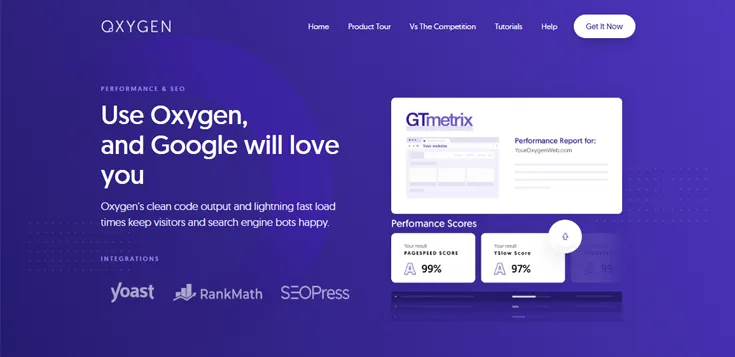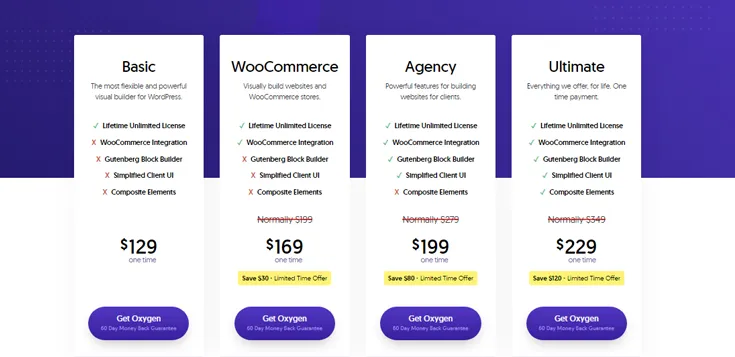WordPress Oxygen Builder vs. Elementor: Which is Better?
- Anurag Pandey
- Last updated on June 10, 2024
- eCommerce
- 9 minutes read
Table of Contents
- What is Oxygen Builder?
- Features of Oxygen Builder
- Advantages of using WordPress Oxygen Builder
- Disadvantages of using WordPress Oxygen Build
- What is Elementor?
- Features of Elementor
- Advantages of using Elementor
- Disadvantages of using Elementor
- Here’s the price chart for Elementor
- Oxygen Builder vs. Elementor: What’s the Difference?
- Conclusion: What’s the Best WordPress Page Builder?
In everyday life, we like to analyze and rank things. We rank our favorite sports teams or compare the newest phone to a competitor’s. The same holds true for our web design software: in this post, we’re going to compare WordPress Oxygen Builder vs WordPress Elementor Builder in regards to their strengths, weaknesses, and uses.
What is Oxygen Builder?
As mentioned above, Oxygen Builder allows anyone to create websites without any coding knowledge. Oxygen Builder gives designers and developers a chance to focus on design. The difference between Oxygen Builder and other similar tools is that Oxygen Builder is not just a visual editor. It’s a fully functional WordPress theme design tool that enables you to create sites with no coding experience whatsoever. The features included in Oxygen Builder are astounding, and the interface is incredibly user-friendly and intuitive.
Features of Oxygen Builder:
1. Convenience:
Oxygen Builder supports nearly all major WordPress plugins, and has built-in drag & drop page builder.
2. Looks:
You can easily create layouts with the built-in page builder and customize them down to the smallest details.
3. All Features:
With Oxygen Builder you can create any kind of website, from simple blog sites to landing pages and complex eCommerce stores. If you choose to purchase anything from the developer, you’ll get access to even more tools and features that allow you to build more advanced websites with ease.
4. Mobile-Friendly:
Oxygen Builder works on both desktop and mobile devices. While designing your site, you can access the desktop version via your browser, and the mobile version via a special link.
Advantages of using WordPress Oxygen Builder:
1. Website Speed Optimization:
Creating websites is made incredibly easy and fast with Oxygen Builder. The drag & drop page builder enables you to create almost any layout you can think of.
2. Functionality:
With Oxygen Builder, you can access tools to create custom WordPress themes and plugins. You can also add and edit custom elements on your site without the need to touch a single line of code (as long as your theme supports them).
3. Theme Customization:
Oxygen Builder includes a library of amazing design elements that let you build unlimited websites without writing any code (custom post types, header images, header fonts and sliders are all included).
Disadvantages of using WordPress Oxygen Build
1. Oxygen Builder Price:
Although you can download Oxygen Builder for a limited time offer of $199 for an agency and use an unlimited number of templates and built-in tools to create simple websites, the opportunities for customization are somewhat limited. For more advanced websites, you will need to purchase a paid plan and gain access to more advanced tools.
2. Knowledge Required:
The biggest disadvantage of Oxygen Builder is that it requires a certain amount of design knowledge. A basic understanding of how WordPress works is a must if you want to get the most out of this tool.
Here’s the price chart for Oxygen Builder:
Note:
Oxygen is clean, lean, and bloat-free.
Here’s a chart comparing the amount of CSS & JavaScript loaded by default on blank pages built with Divi, Elementor, Beaver Builder, and Oxygen.
What is Elementor?
Elementor can be described as the least advanced of the three tools we’re comparing (in terms of design capabilities). The Elementor has an extremely simple interface, but it can still be used by anyone who knows how to use WordPress. The Elementor is a WordPress page builder that allows you to create stunning websites without writing a single line of code. It Elementor is excellent for both beginners and advanced users. Beginners will find Elementor to be an invaluable tool, whereas professional web designers will appreciate the advanced customization options on offer.
Features of Elementor:
1. Functionality:
Elementor gives you the ability to create beautifully designed websites without writing a single line of code. And all the code is accessible via a WordPress plugin, so you won’t need to change your theme to get it working.
2. Website Speed Optimization:
If speed is an important factor for you, Elementor is not for you. Elementor has very few pre-built pages and templates (the majority are all custom) and if you have a lot of content on your website and want to change the layout a lot, it may be quite time-consuming to get everything set up properly.
3. All Features:
Elementor has almost all features of Oxygen Builder, including custom post types, sliders, etc. It has all the basic features of a WordPress page builder. The only drawback is that it doesn’t have any advanced features like a WYSIWYG text editor and content builder, which Oxygen Builder features.
4. Elementor Cloud Website Start with USD 99/year :
Elementor Cloud Websites are locked by default. This feature is called Sitelock and means that visitors are blocked from accessing the site unless there is a PIN Code. This enables you to work freely without worrying that users will stumble across your unfinished site.
Advantages of using Elementor:
1. Price:
The pricing set for Elementor is to be around $99 per year for 1000 website downloads.
2. Design:
The design of Elementor is very simple, but also more colorful than Oxygen Builder’s design (backgrounds are mostly white). But if you’re looking for a feature packed page builder that will let you create more complex websites, then Elementor might just be for you!
Disadvantages of using Elementor:
1. Convenience:
Elementor doesn’t have any drag & drop features. It may not be as simple and intuitive to use as Oxygen Builder.
2. Knowledge Required:
Elementor is more complex than other page builders, but its difficulty lies in the fact that it takes a while to figure out how everything works. In comparison to the simplicity of Oxygen Builder, this may be a huge deal-breaker for some folks!
Here’s the price chart for Elementor:

Oxygen Builder vs. Elementor: What’s the Difference?
In short, Oxygen Builder is the more advanced tool, while Elementor has very few limitations. If you’re looking for a tool that will let you build advanced websites, then Elementor might be for you. If you’re looking for a WordPress Page Builder that has more powerful features and won’t require much effort on your part to use, then Oxygen Builder is probably the better choice!
Oxygen User Interface and Ease of Use
Oxygen is a lot less complicated to use than Elementor and it has a much simpler interface. With Oxygen, you can easily control the layout of your page by dragging and dropping modules into place. You also don’t have to be careful about adding additional design elements because any content that’s added will automatically be styled for you.
Elementor User Interface and Ease of Use
Elementor has a much more confusing interface than Oxygen. With Elementor, you have to manually add each module. You also have to be careful about adding content because any content you add will be placed inside the box. There’s also a row of quick-use buttons at the bottom of the sidebar. This is truly where Elementor shines when comparing Oxygen vs Elementor.
For example, Elementor’s own version of Oxygen’s structure menu is called the “Navigator.”
Oxygen Builder Templates:
With Oxygen, you get a very limited number of layout template options. This is definitely a significant problem for those that want to create their own niche website that won’t look like every other site out there. This can be easily resolved by using a third-party theme with the same layout scheme as Oxygen so that you can use some of the same design elements.
Elementor Templates:
With Elementor though, you have TONS of different layout options for each module. This means that you can create almost any design.
However, there are a lot of different choices when it comes to Elementor themes. From the standard to the creative, we’ve seen everything with Elementor.
Drag and Drop Builder:
WordPress Oxygen Builder:
There’s a lot to love about the drag-and-drop builder. It really does help you reorganize the page with ease. The only thing you’ll find difficult is learning how to navigate the interface.
Column layouts are most recognizable as they’re used by almost all page builder plugins. Oxygen has six.
You can also control spacing by applying specific properties to all child elements within an individual section. Choose to have all elements stack vertically or horizontally, then choose an alignment.
WordPress Elementor Builder:
Elementor is technically a drag-and-drop builder. However, that’s only if you have the “Advanced Mode” turned on in your Elementor Options panel. Without it, you actually have to edit the code for each individual module. This might be why so many people think that Elementor Builder is not a true drag-and-drop builder like Oxygen is.
We know for a fact though, that there are many Elementor users out there that create their page designs in Advanced Mode, and who are incredibly happy with their results! So technically speaking, you can say that both builders do indeed offer a drag-and-drop option for creating your website design inside of the builder app itself.
Conclusion: What’s the Best WordPress Page Builder?
When it comes to both of these comparisons, there’s no clear winner. If you are looking for a website builder in terms of simplicity then Elementor takes the bag here and if you are looking for something in terms of speed and flexibility then the choice goes to Oxygen Builder. Both of these are incredibly well-designed and well-equipped. Oxygen Builder has a better and steeper learning curve and it forces you back to the basics such as CSS than a website that is created and functioned by Elementor
Contact Us-
Email id:- contact@controlf5.in
Anurag Pandey
Recent Posts
Categories
Hire Developers
About us
Popular Posts
Tags
Related Articles
How to Use Upsell: 10 Techniques to Boost Your Sales
Ah, the upsell—the salesperson’s best friend. When done correctly, it can also be very popular with clients. Many businesses use ads, emails, seasonal deals, and coupon codes to drive traffic and acquire new consumers. However, many ecommerce store owners overlook the need to raise the average order value.
10 Reasons to Use WooCommerce to Start Your ecommerce Business
Do you want to build an online store? Then take a tour of WooCommerce.
Every year, thousands of new ecommerce firms are launched. When it comes to selecting a platform for new online businesses, there is no shortage of possibilities.
How to Build Your Store on Shopify: Learn from D2C/B2C Experts
Do you want to swiftly and easily launch a B2C or D2C eCommerce store? Shopify might be the best eCommerce platform for you! It lets developers to easily construct, launch, and administer their online stores.
Sign up for our Newsletter
















